
This resource is an interactive google slide where students are able to create arrays using shapes within google slides to solve division equations.
- Subject:
- Mathematics
- Material Type:
- Activity/Lab
- Author:
- NYASIA ADAMS
- Date Added:
- 07/08/2020

This resource is an interactive google slide where students are able to create arrays using shapes within google slides to solve division equations.

This resource can be used through Google Slides or Peardeck. The Mini-Lesson will cover the following “I Can” Statement.I can determine rules in number patterns.
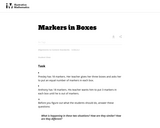
This is a task from the Illustrative Mathematics website that is one part of a complete illustration of the standard to which it is aligned. Each task has at least one solution and some commentary that addresses important asects of the task and its potential use. Here are the first few lines of the commentary for this task: Presley has 18 markers. Her teacher gives her three boxes and asks her to put an equal number of markers in each box. Anthony has 18 markers. His teach...
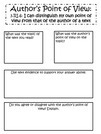
This graphic organizer can be used with any informational text to determine the author’s point of view. Students will use this graphic organizer to determine the topic of a text, the author’s point of view of a text, provide supporting details, and state their own opinion of a text. This could be used with a tech tool where students can draw or type directly on the document (Nearpod, Peardeck, Seesaw, Etc.)

This graphic organizer can be used with any informational text to determine the author’s point of view. Students will use this graphic organizer to determine the topic of a text, the author’s point of view of a text, provide supporting details, and state their own opinion of a text. This could be used with a tech tool where students can draw or type directly on the document (Nearpod, Peardeck, Seesaw, Etc.)

This graphic organizer can be used with any informational text to determine the author’s point of view. Students will use this graphic organizer to determine the topic of a text, the author’s point of view of a text, provide supporting details, and state their own opinion of a text. This could be used with a tech tool where students can draw or type directly on the document (Nearpod, Peardeck, Seesaw, Etc.)This is a link to the same graphic organizer but in Google Slides. The teacher could assign it in Google Classroom for the students to respond to. Google Slides Organizer

After learning about the 3 States of Matter, students can be tested using a pop quiz to check for understanding of the subject, how they transfer from one state to another and also how they are able to illustrates the states of matter either through a drawing of a real life example of the state of matter or the state of matter as a particle. (3.P.2.1, 3.P.2.2, 3.P.2.3)

After learning about the 3 States of Matter, students can be tested using a pop quiz to check for understanding of the subject, how they transfer from one state to another and also how they are able to illustrates the states of matter either through a drawing of a real life example of the state of matter or the state of matter as a particle. (3.P.2.1, 3.P.2.2, 3.P.2.3)
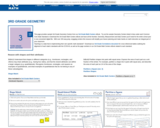
Great for math centers that align with the 3rd grade Geometry unit!

This parent guide supports parents in helping their child at home with the 3rd grade Math content. Within the folder you will access Parent Guide PDFs in FIVE Languages: Arabic, English, Hindi, Spanish, and Vietnamese to help on-going communication with caregivers.

This resource accompanies our Rethink 3rd Grade Math Course. It includes ideas for use, ways to support exceptional children, ways to extend learning, digital resources and tools, tips for supporting English Language Learners and students with visual and hearing impairments. There are also ideas for offline learning.

This resource accompanies our Rethink 3rd Grade Science course. It includes ideas for use, ways to support exceptional children, ways to extend learning, digital resources and tools, tips for supporting English Language Learners and students with visual and hearing impairments. There are also ideas for offline learning.

This parent guide supports parents in helping their child at home with the 3rd grade Social Studies content. Within the folder you will access Parent Guide PDFs in FIVE Languages: Arabic, English, Hindi, Spanish, and Vietnamese to help on-going communication with caregivers.

This resource accompanies our Rethink 3rd Grade Science course. It includes ideas for use, ways to support exceptional children, ways to extend learning, digital resources and tools, tips for supporting English Language Learners and students with visual and hearing impairments. There are also ideas for offline learning.

Design and build a sleigh using a WeDo kit, K’nex or similar, that will pull a specific measured weight.
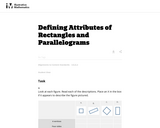
This is a task from the Illustrative Mathematics website that is one part of a complete illustration of the standard to which it is aligned. Each task has at least one solution and some commentary that addresses important asects of the task and its potential use. Here are the first few lines of the commentary for this task: Look at each figure. Read each of the descriptions. Place an X in the box if it appears to describe the figure pictured. A. B. C. D. 4 vertices Four si...
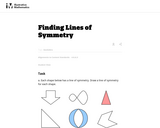
This is a task from the Illustrative Mathematics website that is one part of a complete illustration of the standard to which it is aligned. Each task has at least one solution and some commentary that addresses important asects of the task and its potential use. Here are the first few lines of the commentary for this task: Each shape below has a line of symmetry. Draw a line of symmetry for each shape. Not every shape has an line of symmetry. Which of the four shapes belo...
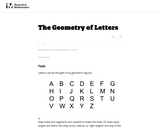
This is a task from the Illustrative Mathematics website that is one part of a complete illustration of the standard to which it is aligned. Each task has at least one solution and some commentary that addresses important asects of the task and its potential use. Here are the first few lines of the commentary for this task: Letters can be thought of as geometric figures. How many line segments are needed to make the letter A? How many angles are there? Are they acute, obtu...
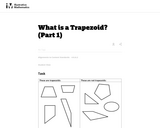
This is a task from the Illustrative Mathematics website that is one part of a complete illustration of the standard to which it is aligned. Each task has at least one solution and some commentary that addresses important asects of the task and its potential use. Here are the first few lines of the commentary for this task: Say what a trapezoid is in your own words. Compare your definition with a partner. Is this parallelogram a trapezoid according to your definition? Expl...
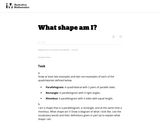
This is a task from the Illustrative Mathematics website that is one part of a complete illustration of the standard to which it is aligned. Each task has at least one solution and some commentary that addresses important asects of the task and its potential use. Here are the first few lines of the commentary for this task: Draw at least two examples and two non-examples of each of the quadrilaterals defined below. Parallelogram: A quadrilateral with 2 pairs of parallel si...